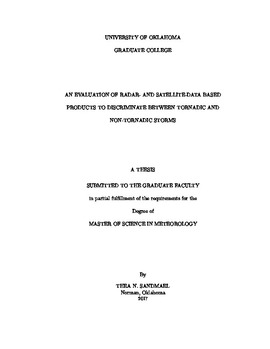| dc.description.abstract | Severe weather, and specifically tornadoes, can pose a significant threat to property and human life. Tornadic storms have been extensively studied using radar observations for decades, and some more recent studies have started to incorporate satellite-derived variables when investigating thunderstorms. In preparation for GOES-16 operations, characterized by increased temporal and spatial resolution over existing geostationary satellite imagery, a dataset of several thousand storms are analyzed using NEXRAD WSR-88D radar observations and 1-minute super-rapid scan GOES-14 observations from cases during 2011-2016. Radar-based storm tracks and parallax corrections (applied to GOES imagery) are used in order to facilitate detailed storm-based comparisons between the datasets, and to link individual storms to tornado reports from the National Centers for Environmental Information.
The goal of this study is to determine if tornadic storms exhibit any distinguishing features from non-tornadic storms in this combined dataset, and how far in advance of a tornado the data would display any distinctive characteristics. The variables examined include dynamical variables such as rotation and divergence (radar and satellite), implied ascent from single-Doppler radar winds, polarimetric radar signatures, and overshooting tops (radar and satellite). The project incorporates statistical methods for analysis. The data is partitioned into storm populations and modes based on linkages with observed tornadoes and distinct physical and/or dynamical characteristics. Assessments of convective updraft characteristics from the radar and satellite datasets are strong discriminators for tornadic and non-tornadic storms. The data also exhibits differences for separate tornado intensities, where the storms that produce stronger tornadoes on the Enhanced Fujita scale have stronger updrafts during the tornadoes.
The results were tested with a simple, objective threshold method and compared to the National Weather Service's tornado warnings for the same storms, which resulted in higher probability of detection and lead time at a comparable false alarm ratio and skill for the objective method. A more sophisticated method of utilizing these results could be incorporated into nowcasting algorithms in order to improve lead time for tornadoes or increase the confidence of a tornado being present when observations are limited. | en_US |
